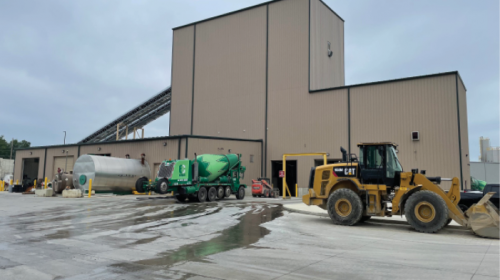New technology has sparked a revolution in concrete batch accuracy.
The Fourth Industrial Revolution, commonly known as Industry 4.0, is the ongoing automation of manufacturing using Internet of Things (IoT), widespread machine-to-machine (M2M) communication, and artificial intelligence (AI). When we cut through the buzzword bingo, it’s clear that Industry 4.0 matters when it comes to batching ready-mix concrete.
Batch accuracy requirements are driven by structural safety. With expensive equipment and plenty of time, that 28,000 lb. batch could be made with pharmaceutical accuracy: it’s just not needed. Achieving industry accuracy goals is thus an optimization between the expense of the equipment and “expense” of the time required to batch.
Randy Willaman, founder of Willaman Solutions, and Ben Yost, vice president of Ernst Concrete’s Columbus, Ohio division, are advancing the optimization of batching by pushing forward with Industry 4.0. Willaman has developed a cloud-based performance scorecard directly linked to modern batchers in real-time. This empowers a host of actionable decisions, some of which can plug immediate profit leaks and others that reduce malignant liability. Equally important, it sets the stage for future batch equipment design to incorporate input from all plant devices through M2M communication with IoT.
Willaman is undisputedly the foremost global expert in modern concrete batching. He has spent decades developing batching software and working with batch plant manufacturers to optimize the best combination of equipment and speed. He cautions that once running, plants are “out of sight, out of mind,” while just about every other aspect of the concrete business is highly scrutinized. He wants to change this.

THE USUAL SUSPECTS
Batch plants have two main challenges: Holding tolerance and operating at the highest possible production rate. The “usual suspects” that slow down batching are erratic flow rates from cementitious materials, excessive jogging for aggregates, and for dry batch, discharge rate from the aggregate weigh hopper to the boot via the conveyor belt. The usual suspects for out of tolerance batching are admix pulse meters, auger-fed cementitious materials, and sticky or worn gates.
Excessive jogging, especially for loads less than 50 percent of scale capacity, clumpy cement and fly ash, and slow weigh hopper discharge flow can easily add 90 seconds to the time of a batch. Any given weighment error is typically very small and will not impact structural integrity, but it is indeed out of tolerance. Through M2M, IoT and the cloud, Willaman and Yost are working to capture all of these factors in real-time for continuous optimization of the plant.
“With an analytics dashboard we’re able to see, plant by plant, where we need to fine tune specific areas,” says Yost. “It’s much easier to see where we’re losing time or need to dial in materials, on a daily basis or over a period of time, and we can do it without having to be onsite.”
When opportunities for improvement are discovered, the Ernst team implements appropriate plant modifications. Yost stresses the combination of modern technology and operational know-how needed to capture efficiencies. “Once we have more data from the plant, we can address limitations or problems,” he says. “For example, we may put in a new water valve that adds a fraction of a second to each load, but increases our accuracy—ultimately resulting in higher quality and less time adjusting issues.”
Production rate matters, but it’s hard to put incremental improvements into economic terms. During peak demand the plant can cause delays and extend truck and driver cycle time. Further, large paving or warehouse pours demand high production rates and if a plant cannot keep up trucks must be sent from a second, more distant location or an expensive, portable setup. Optimized plant performance helps.

SHOW ME THE MONEY
The temptation is to add up all the saved minutes, multiply by the truck and driver costs per minute, and voila, show a savings. The hard truth is that to show a profit there must be enough time savings per truck per day to squeeze in another load or reduce overtime. Improving plant throughput is “directionally correct,” especially for high peak demands or dedicated high volume jobs. Yet, a generalized financial case just cannot be made given all the moving parts.
News flash: Nearly half of ready-mix plants run 25-35 percent out-of-tolerance loads, day after day. Almost all errors are tiny and will not impact structural integrity. However, for applications like bridges, columns, and others, the batch weights will be checked and, depending upon the inspector, a portion will be rejected.
At Ernst, operational data is fed to the cloud through Willaman Solutions’ DataJet solution and then analyzed via the PerforMax dashboard. “I’m excited to see more data analytics coming into our industry,” says Yost. “We’ve seen other segments like shipping and transportation do amazing things with their data. Now we’re getting more technology that’s geared toward gathering the information we need from all aspects of our business.”

Craig Yeack has held leadership positions with both construction materials producers and software providers. He is co-founder of BCMI Corp. (the Bulk Construction Materials Initiative), which is dedicated to reinventing the construction materials business with modern mobile and cloud-based tools. His Tech Talk column—named best column by the Construction Media Alliance in 2018—focuses on concise, actionable ideas to improve financial performance for ready-mix producers. He can be reached at [email protected]